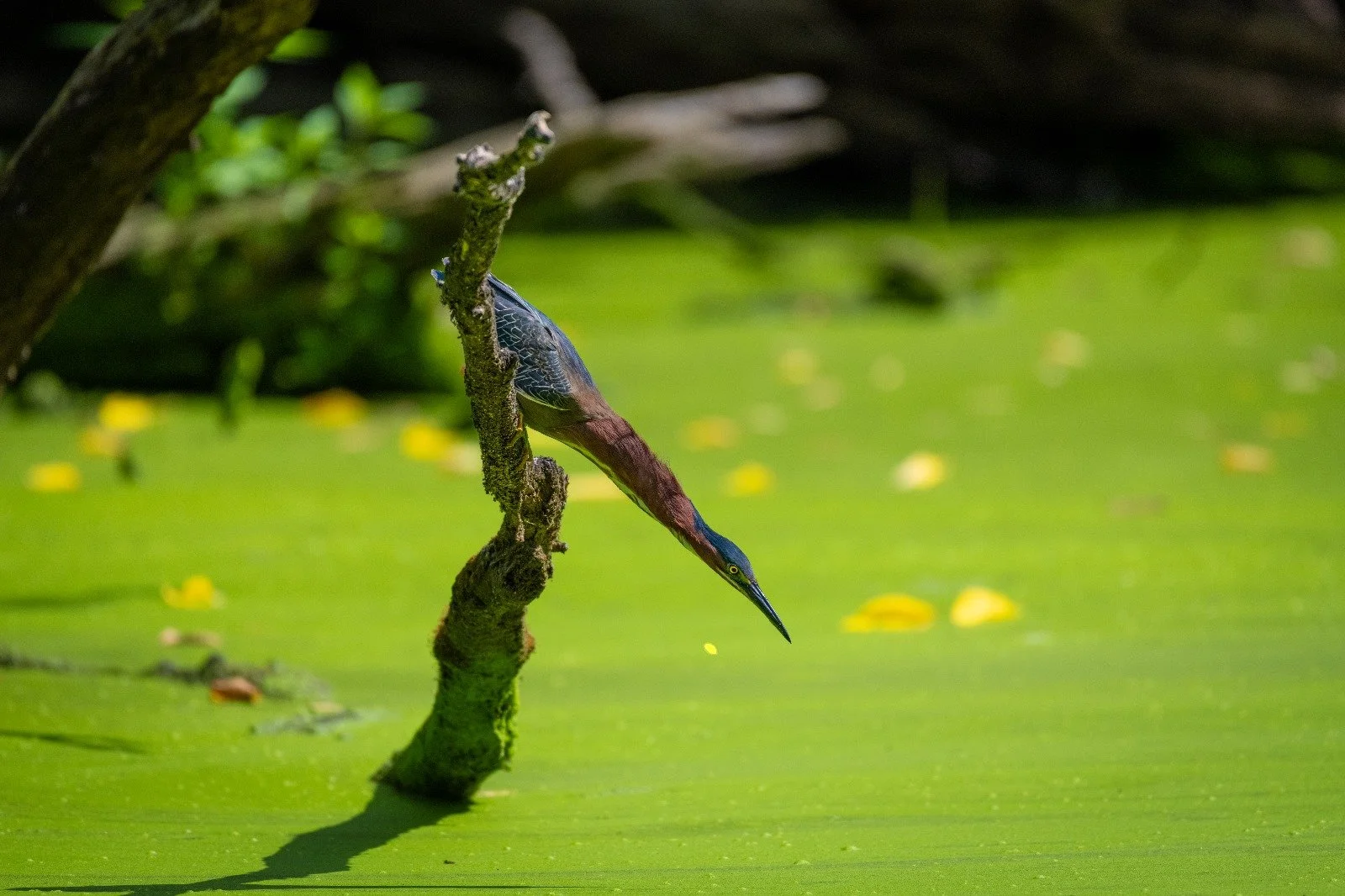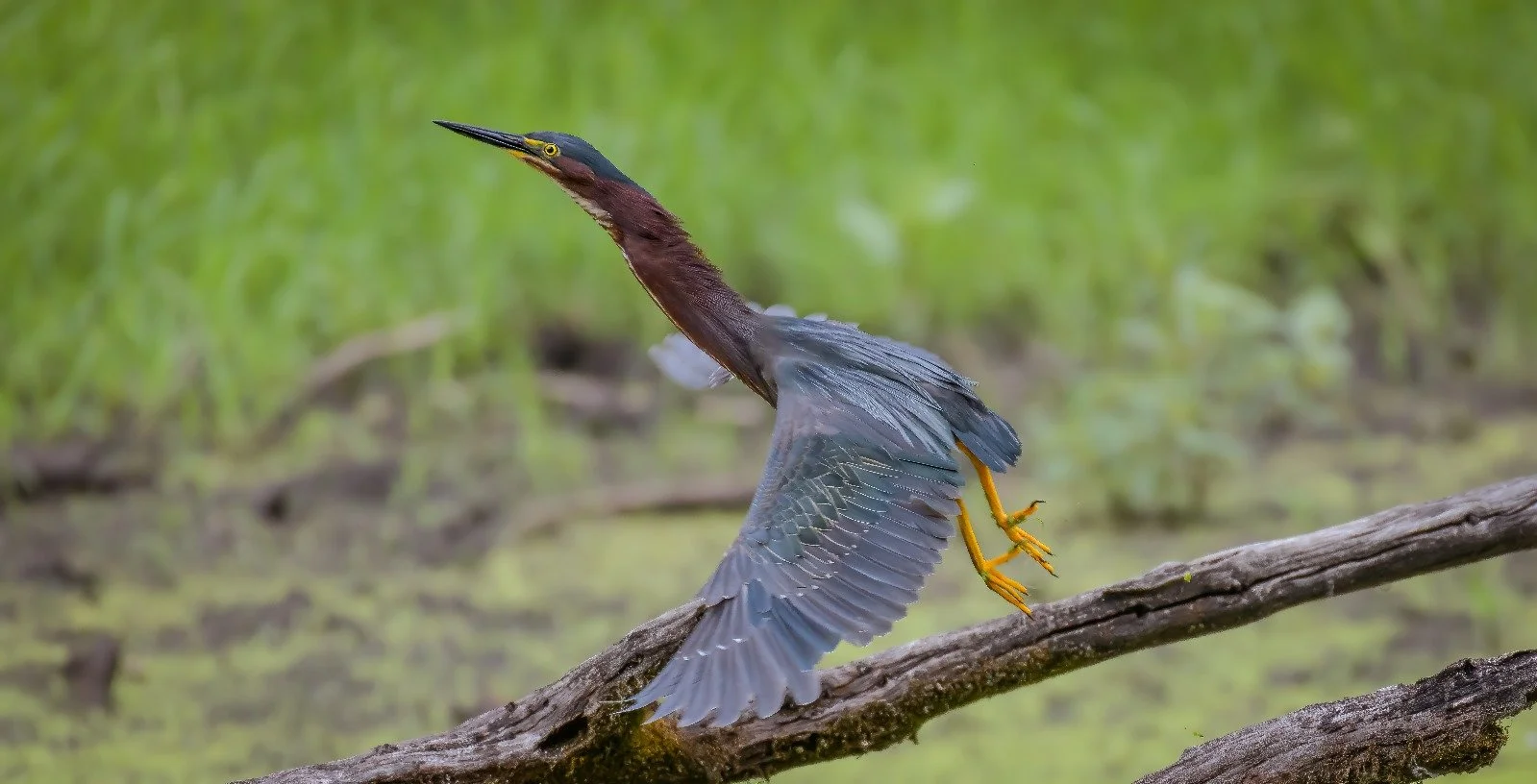The Green Heron Chronicles: A Wildlife Photographer’s War of Attrition
The Phantom Strike
At 4:47 AM on a Tuesday morning, I witnessed something extraordinary. A green heron, perched on a moss-covered branch over still water, executed a hunting sequence so precise and lightning-fast that it seemed almost supernatural. The bird coiled its neck like a loaded crossbow, paused for a microsecond of target acquisition, then exploded into motion—wings spread wide for balance, body stretched to its anatomical limits, bill aimed with surgical precision at some unseen prey below.
The entire sequence lasted perhaps three seconds. I captured none of it.
The Obsession Begins
That single moment ignited a five-day siege that would test every aspect of my patience, technical skill, and physical endurance. Green herons aren’t just difficult subjects—they’re photographic phantoms that exist in a perpetual state of hypervigilance, ready to vanish at the slightest provocation.
Day One: The Reconnaissance
I arrived at first light, camera gear arranged like a sniper’s nest. The green heron appeared around 6:30 AM, but every approach sent it melting into the cattails like smoke. These birds don’t just fly away—they materialize and dematerialize with the stealth of special operations.
Images captured: 47
Usable frames: 0
Day Two: The Phantom Menace
The heron returned to the same hunting perch. I positioned myself 40 feet away, lens trained on the exact spot where I’d witnessed the strike. For three hours, the bird remained motionless except for the occasional head turn that sent my heart racing.
At 8:23 AM, it happened again—the explosive hunting sequence in all its predatory glory. This time I was ready. My finger found the shutter release, the camera fired…
And a mosquito chose that exact moment to land on my cheek.
The involuntary swat came faster than conscious thought. The heron spooked. The moment evaporated.
I killed that mosquito with the fury of a thousand suns.
Images captured: 234
Usable frames: 3 (blurry takeoff shots)
Days Three Through Five: The Grind
What followed was a masterclass in wildlife photography’s most brutal lesson: nature operates on its own timeline, not yours. Each morning brought the same ritual—pre-dawn setup, motionless waiting, the gradual building of hope, followed by the crushing weight of near-misses.
Green herons hunt with the patience of Zen masters and the speed of lightning. They can remain statue-still for an hour, then explode into motion faster than human reflexes can follow. Every photographer who’s attempted this sequence knows the frustration of seeing the perfect moment unfold while your camera captures nothing but empty air.
The Technical Gauntlet
Photographing green heron hunting behavior presents a perfect storm of technical challenges:
Exposure Nightmares: The birds hunt in dappled light conditions where highlight and shadow dance across the frame. One moment you’re dealing with dark, shadowed water; the next, brilliant reflected light off the surface.
Focus Acquisition: Green herons move through multiple focal planes in milliseconds. Continuous autofocus struggles with the rapid depth changes, while single-point focus can’t track the erratic movement patterns.
Shutter Speed Paradox: You need fast shutter speeds to freeze the explosive motion, but the early morning light demands higher ISOs that compromise image quality. It’s a constant balance between technical perfection and acceptable compromise.
Compositional Chaos: Unlike the predictable movements of great blue herons, green herons are compositional wildcards. They strike from impossible angles, their compact bodies twisting through space in ways that challenge every rule of wildlife photography composition.
The Breakthrough: Day Six
At 8:17 AM, everything aligned. The heron appeared on its favored perch, light conditions were optimal, and my camera settings were dialed to perfection. More importantly, I had learned to read the bird’s micro-behaviors—the subtle head tilts, the gradual neck compression, the microscopic weight shifts that preceded the strike.
When the sequence began, I was ready.
Frame 1: The reconnaissance—bill angled downward, body coiled with potential energy, every muscle fiber primed for the explosion to come.
Frame 2: The commitment—wings spread wide, body extended to its anatomical limits, the point of no return captured in crystalline detail.
Frame 3: The strike—the final descent, form following function with deadly precision.
Three frames. Three seconds. 28 hours of preparation.
The Green Heron Reality
This species represents wildlife photography at its most challenging. Unlike the accommodating great blues or the predictable great egrets, green herons are creatures of shadow and stealth. They hunt in locations that defy clean composition, move with speeds that challenge even the fastest cameras, and maintain a level of wariness that makes close approach nearly impossible.
Why They’re Photography’s Ultimate Test
Behavioral Unpredictability: Green herons don’t follow patterns. They might hunt from the same perch for days, then suddenly abandon it for reasons known only to them.
Environmental Challenges: They prefer hunting locations that are photographically problematic—dense vegetation, poor lighting, cluttered backgrounds.
Physical Demands: The waiting game is brutal. Hours of motionless vigilance in uncomfortable positions, often in insect-infested environments.
Technical Precision: There’s no room for error. The hunting sequence happens too fast for second chances, and the birds are too wary to tolerate multiple approaches.
The Psychological Warfare
Perhaps the most challenging aspect is the mental game. Green herons will test your resolve, your patience, and your commitment to the craft. They seem to sense when you’re most vulnerable—when your attention wavers for just a moment, when you’re adjusting settings, when you’re swatting that perfectly timed mosquito.
The Payoff
After 2,863 images across six days, I emerged with a three-frame sequence that captures one of nature’s most elusive behavioral moments. But the real prize wasn’t the photographs—it was the education in dedication, the lesson in persistence, and the reminder that wildlife photography’s greatest rewards come to those willing to endure its most demanding challenges.
The green heron taught me that sometimes the most valuable shots aren’t the ones that come easily, but the ones that demand everything you have to give. In return, you get more than just photographs—you get a story, a journey, and the deep satisfaction that comes from earning your images through pure, relentless commitment.
Final Frame Count
- Total hours invested: 28
- Total images captured: 2,863
- Portfolio-worthy sequences: 1
- Mosquitoes eliminated: 1 (with extreme prejudice)
- Lessons learned: Immeasurable
The Green Heron Code
If you’re considering stalking these photographic phantoms, remember:
- Patience is your primary weapon. These birds operate on geological time scales punctuated by explosive action.
- Respect the bird’s space. Push too hard, and you’ll be photographing empty perches for the rest of the season.
- Prepare for the long game. This isn’t a quick morning shoot—it’s a commitment that might span days or weeks.
- Embrace the failures. Every missed shot teaches you something about timing, positioning, or the bird’s behavior patterns.
- Trust the process. The sequence will happen when it happens, not when you want it to.
The green heron doesn’t give up its secrets easily. But for those willing to wage the war of attrition, the rewards are beyond measure. In a world of instant gratification, these birds demand something increasingly rare: true dedication to craft.
And sometimes, that’s exactly what we need.






